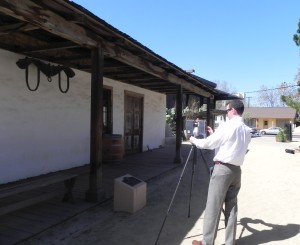Suppose the 216-year-old Peralta Adobe, San Jose’s oldest structure, was damaged in an earthquake. Could History San Jose, its caretaker, reconstruct it?
The nonprofit is about to find out with a project called Capturing History San Jose, which is being launched through a partnership with a startup, NVentum. Using a sophisticated 3D camera, the adobe’s walls and interior will be scanned in precise detail. With Trimble Navigation software, the result is an online 3D replica of the adobe and an architectural blueprint of the only remaining relic of Pueblo de San Jose de Guadalupe, founded in 1777.The eventual goal is to create living models of the 32 building in the 14-acre History Park and the 500,000 artifacts in the city’s collection.
“There is so much rich history that it’s difficult for a museum to share,” said History San Jose’s Director Alida Bray. “Once it is in the computer there are a myriad of things you can do.”
Last month, the FARO Focus 3D was set up for a demonstration at the adobe, which is now at the center of the vibrant San Pedro Square Market. By creating a model of the adobe – History San Jose’s oldest and smallest structure — Bray hopes to draw interest to fundraise for the project. NVentum, FARO and Trimble Navigation are providing services and tech support pro bono. Help is also coming from CyArk, a nonprofit with a mission to preserve cultural heritage sites.
Here’s how VNentum describes the technology:
Using a low power laser beam, the surface of any object can be precisely measured and recorded in three dimensions, without contact with its surface. A laser scanner projects a thin strip of low power laser light onto the surface of the object. A digital camera records the light as it is reflected on the surface. The relative positions of the light source and camera allow the surface of an object to be mapped as a series of 3D data points, called a point cloud.
After scanning in several locations, FARO Technologies’ Matt Daly was able to produce an online tour through the adobe’s two rooms. Quickly, he showed how a rustic cowhide chair in the bedroom could be formatted for a viewer to click on to find out how it was made and other information that might not be included on a tour. Through a blueprint created at the same time, a viewer could see that one of the adobe’s walls is 1.87 feet thick.But will a virtual tour discourage viewers from visiting the genuine History Park in Kelley Park on Senter Road? NVentum’s VP Brian Miller believes the opposite.
“We can put everything in a virtual environment. There are 500,000 items you can see in greater detail than you could see in a normal photograph,” he said. “If you can get people to understand what the museum holds, you can get them to come to the park.”
History San Jose’s Collections Manager Ken Middlebrook sees the tools as providing access while preserving artifacts.
“My concern is protecting the artifact,” she said. “The less you can handle the object the better.”
He gives as example an 1842 Lefebvre Bicycle, the oldest in the Western Hemisphere, which is housed at the collections center on San Jose’s Senter Road, out of the view of the public. The unique wood and iron model with pedals that go up and down was made in France and brought to the East Bay by immigrants. In the 1950s, the bike was donated to the city.The bicycle could be scanned from various angles so the world could dissect its measurements, design and construction with such detail that researchers could reconstructs its unusual pedal design, Middlebrook said.
As funding is found, Capture History San Jose would be phased in over two years, with the next step to buy a couple cameras, which cost $50,000 each, to scan History Park’s buildings, followed by scanning the nearly half a million artifacts in the collection center. Phase 3 would be developing and implementing a Building Information Model, a data base for operating History Park that includes controlling climate, humidity levels and energy audits.
